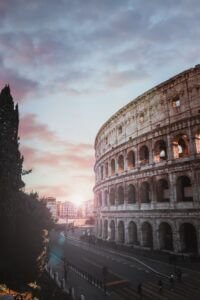Check Full Video HERE
Rome, Italy: A Journey Through Time and Culture
Historical Significance: Rome, the Eternal City, has its origins around 1000 BC and became the epicenter of one of history’s most powerful and advanced empires. The Roman Empire is renowned for its contributions to law, literacy, and infrastructure, influencing vast territories across Europe, Asia, and Northern Africa. Rome’s legacy includes groundbreaking architectural and engineering feats that continue to inspire modern civilization.
Major Attractions:
- Roman Forum: Once the heart of ancient Rome, this complex of ruins offers a glimpse into the social and political life of the empire.
- Coliseum: An iconic symbol of Rome, this ancient amphitheater hosted gladiatorial battles and public spectacles.
- Palatine Hill: As one of the most ancient parts of the city, it provides a panoramic view of the ruins and insights into Rome’s founding legends.
- Pantheon: A marvel of ancient engineering, this temple with a vast dome is a testament to Roman architectural ingenuity.
- Spanish Steps: A beautiful Baroque staircase connecting Piazza di Spagna with the Trinità dei Monti church, a popular spot for tourists and locals alike.
- Vatican City: The seat of the Roman Catholic Church, home to St. Peter’s Basilica and the Vatican Museums, including the Sistine Chapel.
Tourist Tips:
- To avoid the crowds, visit popular sites like the Coliseum early in the morning.
- Purchase tickets for the Coliseum and Palatine Hill together to save time, as the lines at Palatine Hill are often shorter.
- Renting a scooter can be a convenient and fun way to navigate the city’s narrow streets and discover hidden corners.
Cultural Insights: The Coliseum, known for its gladiator battles, was a place where social classes mingled freely, with entry often free for spectators. Gladiators, frequently slaves or prisoners, fought for glory and the chance to earn their freedom. Interestingly, there were also female gladiators who participated in these brutal contests.
Modern Experiences: Rome isn’t just about ancient history; it’s a vibrant city with much to offer:
- Trastevere: This lively neighborhood is perfect for experiencing authentic Italian cuisine and discovering local hidden gems.
- Villa Borghese: A large public park ideal for a relaxing stroll or a picnic, offering a peaceful retreat from the city’s hustle and bustle.
- Chapter Roma: Located in the historic Jewish Ghetto, this modern hotel provides luxurious accommodations amidst a rich historical backdrop.
Rome is a city where past and present coexist harmoniously, offering a unique blend of history, culture, and modernity. Whether you’re exploring ancient ruins, savoring Italian delicacies, or relaxing in a local park, Rome promises an unforgettable experience
Rome, Italy: Essential Travel FAQ
1. When’s the best time to visit Rome?
Experience Rome at its most enchanting during the spring (April to June) and autumn (September to October). These months feature delightful weather and fewer tourists, making your explorations all the more magical.
2. How can I skip long lines at popular spots?
Get a head start on the day by visiting landmarks like the Coliseum early in the morning. Buying tickets at less crowded entries, such as the Palatine Hill for combined access, can also minimize waiting times.
3. What’s the best way to get around Rome?
Navigating Rome on a scooter adds a fun twist to sightseeing, and it’s quite practical! The city’s comprehensive public transit system, including buses, trams, and metro, also makes getting around straightforward. Plus, walking is a pleasure as many sites are clustered together.
4. Are there any free things to do in Rome?
Rome is abundant with free attractions. Wander through the Pantheon, Spanish Steps, and Trevi Fountain without spending a euro. Explore serene churches and lively squares at no cost, and remember that many museums and archaeological sites offer free entry on the first Sunday of each month.
5. What food should I try in Rome?
Taste the essence of Rome with classic pasta dishes like carbonara, cacio e pepe, and amatriciana. Don’t miss out on supplì (crispy fried rice balls) and Roman-style pizza. And for dessert, gelato is an absolute must!
6. Do I need to tip in restaurants and cafes?
While tipping isn’t mandatory, it is a kind gesture that is always appreciated. A tip of 5-10% in restaurants and a small amount of change in cafes can go a long way.
7. What should I wear when visiting religious sites in Rome?
Dressing modestly is important at sacred sites like St. Peter’s Basilica. Cover your shoulders and knees, and steer clear of shorts, short skirts, and sleeveless tops.
8. Is Rome safe for tourists?
Rome is largely safe for visitors, but staying alert in crowded places and on public transport is wise. Keep an eye on your personal belongings and exercise caution with strangers to ensure a smooth experience.
9. Can I drink the tap water in Rome?
Yes, Rome’s tap water is safe and refreshing. The city is dotted with “nasoni” fountains providing clean drinking water, so feel free to refill your bottle as you explore.
10. What are some hidden gems in Rome?
Uncover Rome’s secret wonders at the Catacombs of San Callisto, the Protestant Cemetery, the historic Appian Way, and the unique Quartiere Coppedè.
11. How do I visit Vatican City?
Vatican City is easily accessible and a must-see. Entry to St. Peter’s Basilica is free, though lines can be long. For a seamless visit to the Vatican Museums and Sistine Chapel, book your tickets online ahead of time.
12. Where can I find authentic nightlife in Rome?
For a vibrant night out, head to Trastevere, where the energy is infectious, with a plethora of bars, restaurants, and cafes. Campo de’ Fiori, Monti, and Testaccio also offer fantastic nightlife options.
Prepare to be captivated by the rich history, vibrant culture, and picturesque charm of Rome!




